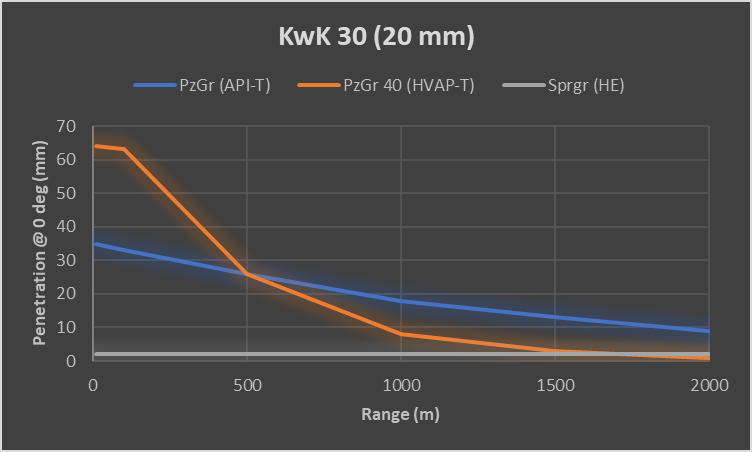KwK30 (20 mm)
Contents
Description
The KwK30 (20 mm) was primarily as the main armament of the Pz.II C and the Pz.II C (DAK). The KwK 30 also served as the basis for the 20 mm C/30L, which was used on the He 112 A-0. An improved version that had a higher rate of fire, the 20 mm KwK 38, was mounted on the Pz.II F.
Vehicles equipped with this weapon
General info
Available ammunition
| Belts | Shell composition | Combat usage |
|---|---|---|
| Default | API-T · HEFI-T | The belt composition means that 50% of the shells (HEFI-T) are useless against tanks while the other 50% (API-T) is nearly useless against planes. However, this belt is reliable against open-topped or thin-skinned vehicles like SPAA vehicles. Since there are no dedicated high-explosive shells for the selection, having one belt of this in reserve does not hurt for those situations. |
| PzGr | API-T | This belt offers a good transition from the Default to the PzGr 40 APCR belt. The round offers decent use and damage against lightly armoured tanks, especially at close range. Due to lack of high-explosive filler however, it is better to focus on the PzGr 40 belt to maximize penetration power. |
| PzGr 40 | HVAP-T | Probably the best belt with the best penetrating shell for the vehicle. While the damage effects post-penetration can be quite poor, the rapid fire from the autocannon can mitigate this problem by following up quickly with another penetrating shot. In close combat, these shells should be used against modules and crew member to make the most of each shell. Against angled armour, however, the APCR ammo may not be very effective, just like any other APCR shell. |
| Penetration statistics | ||||||
|---|---|---|---|---|---|---|
| Ammunition | Penetration @ 0° Angle of Attack (mm) | |||||
| 10 m | 100 m | 500 m | 1,000 m | 1,500 m | 2,000 m | |
| Default | 36 | 34 | 26 | 19 | 14 | 10 |
| PzGr | 36 | 34 | 26 | 19 | 14 | 10 |
| PzGr 40 | 64 | 63 | 26 | 8 | 3 | 1 |
Comparison with analogues
Give a comparative description of cannons/machine guns that have firepower equal to this weapon.
Usage in battles
The high fire rate and excellent penetration of the Kwk30 allows enemy tanks to be killed quickly. However, a small magazine and a lengthy reload rate allows enemies to fire back and destroy you. After shooting at enemies, take cover to reload. Try to avoid long-range engagements, as the penetration rate drops off rapidly at around 500 m.
Pros and cons
Pros:
- High fire rate, does a lot of damage
- Very good penetration at close to medium ranges
- Decent reload speed of 6~7 seconds
- Better penetration than other 20mm cannons at its rank
Cons:
- Poor penetration when not using HVAP-T shells
- Penetration rate drops rapidly at longer ranges
- Relatively small magazine of 10 rounds
History
Examine the history of the creation and combat usage of the weapon in more detail than in the introduction. If the historical reference turns out to be too long, take it to a separate article, taking a link to the article about the weapon and adding a block "/History" (example: https://wiki.warthunder.com/(Weapon-name)/History) and add a link to it here using the main template. Be sure to reference text and sources by using <ref></ref>, as well as adding them at the end of the article with <references />.
Media
An excellent addition to the article would be a video guide, as well as screenshots from the game and photos.
See also
Links to the articles on the War Thunder Wiki that you think will be useful for the reader, for example:
- reference to the article about the variant of the cannon/machine gun;
- references to approximate analogues by other nations and research trees.
External links
Paste links to sources and external resources, such as:
- topic on the official game forum;
- encyclopedia page on the weapon;
- other literature.
| Germany tank cannons | |
|---|---|
| 20 mm | KwK30 · KwK38 · Rh202 |
| 28/20 mm | s.Pz.B.41 |
| 30 mm | MK 30-2/ABM |
| 37 mm | KwK34(t) · KwK36 · KwK38(t) · PaK L/45 |
| 47 mm | Pak.(t)(Sf.) |
| 50 mm | KwK39 · KwK L/42 · PaK38 |
| 57 mm | Bofors L/70 Mk.1 |
| 75 mm | K51 L/24 · KwK37 · KwK40 L43 · KwK40 L48 · KwK42 · KwK44 · KwK44 L/36.5 · PaK39 L48 · PaK40/3 L46 · PaK42 · StuK37 · StuK40 L43 · StuK40 L48 |
| 76 mm | PaK36 (r) |
| 88 mm | Flak.37 · Flak 41 · KwK36 · KwK43 · PaK43 |
| 90 mm | BK90 |
| 105 mm | CN105-57 · Cockerill HP · FMK.4 Modelo 1L · K.18 · KwK L/68 · L7A3 · PzK M57 · StuH42 |
| 120 mm | Rh120 L/44 · Rh120 L/55 · Rh120 L/55 A1 |
| 128 mm | K.40 · KwK44 · PaK44 |
| 150 mm | s.I.G.33 · Stu.H 43 L/12 |
| 380 mm | RW61 |
| Foreign: | |
| 30 mm | Bushmaster 2 Mk.44 (USA) · HSS 831L (Britain) |
| 57 mm | 6pdr OQF Mk.V (Britain) |
| 73 mm | 2A28 (USSR) |
| 75 mm | M3 (USA) |
| 76 mm | F-32 (USSR) · F-34 (USSR) · M32 (USA) |
| 90 mm | M36 (USA) · M41 (USA) |
| 105 mm | GT-3 (South Africa) |
| 125 mm | 2A46 (USSR) |
| 152 mm | M-10T (USSR) · XM150E5 (USA) |
| 155 mm | M126 (USA) |




